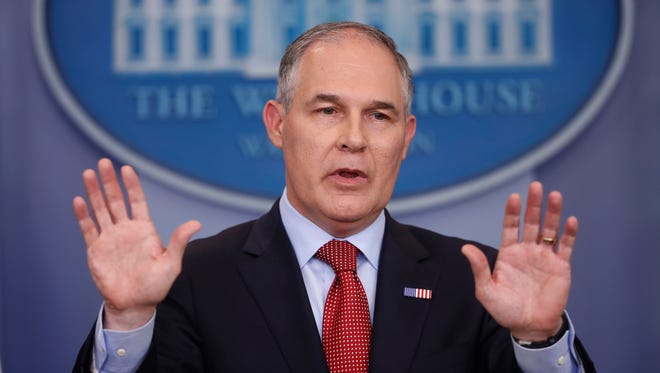Superfund cuts would lead to delays in toxic cleanups, experts warn

WASHINGTON — Experts warned a Senate panel Tuesday that the Trump administration’s proposed 30% cut in the Superfund program would likely delay cleanup at some of the nation’s most toxic sites, especially those requiring complex and lengthy remediation.
“That is going really hurt the program regardless of how one feels about the Superfund program,” Katherine Probst, an expert on Superfund told the Senate Environment and Public Works Committee during a hearing Tuesday. “It’s hard to imagine that you can continue to do long-term cleanups with that kind of a draconian cut.”
Annual federal appropriations for Superfund declined from about $2 billion to about $1.1 billion in constant 2013 dollars from fiscal years 1999 through 2013. Now, as part of a budget that beefs up spending on military and homeland security, Trump is proposing to cut Superfund by nearly a third to $762 million.
Scott Pruitt, administrator of the Environmental Protection Agency which oversees Superfund, has called for streamlining the program and finding ways to speed up completion of sites that have lingered on the National Priorities List for decades.
A report his office released last week suggested a number of ways of expediting cleanup, including greater use of outside parties to monitor conditions, a more aggressive review of sites that have been on the list for at least five years, reassessment of groundwater cleanup goals, and providing polluters more incentives to remediate sites more quickly.
Enacting the 42 recommendations listed in the report would reduce the government-heavy inefficiencies of the Superfund program and help get "these sites cleaned up so that the land is safe for those who build, live or play on it,” Pruitt said in a statement accompanying the release of the report.
Tuesday’s hearing came a day after the EPA added seven more sites to the National Priority List: The Battery Recycling Company in Puerto Rico; the former Custom Cleaners in Memphis; Highway 18 Ground Water in Kermit, Texas; Microfab Inc. in Amesbury, Mass.; Old HWY 275 and N. 288th Street in Valley, Neb.; the Post and Lumber Preserving Co. Inc. in Quincy, Fl.; and the Saint-Gobain Performance Plastics in the Village of Hoosick Falls, N.Y.
President Trump's budget would cut Superfund toxic cleanup program by 30%
EPA chief makes first Superfund site visit
Trump budget plan would squeeze states over environmental programs
The agency also announced another four would be proposed for Superfund status: Newark South Ground Water Plume in Newark, Del.; American Creosote DeRidder in DeRidder, La,; Mississippi Phosphate Corporation in Pascagoula, Ms.; and Eagle Industries in Oklahoma City.
Superfund sites, which include abandoned industrial sites, mining operations and military depots, have been linked to high cancer risks as well as other diseases.
There were 1,845 sites as of Aug. 1, according to the EPA website. An estimated 53 million Americans — about one of every six — live within three miles of a Superfund site, according to Mathy Stanislaus, a former associate administrator in the EPA who oversaw the program for the Obama administration.
There are over 100 non-federal sites where human exposure is not under control, and over 150 sites where there is insufficient information to determine if human exposure is under control, according to Probst.
Cleanup of Superfund sites is paid for primarily by the owner of the operation, such as a mine or chemical factory, that has been identified as the polluter.
But determining the source and scope of culpability often takes years. And it's common that those deemed responsible lack the resources to pay to clean up sites. Even with identifiable culprits, the federal government often has to initiate work on its own especially in public health emergencies and then try to recover costs from polluters.
The program, funded largely by Washington but usually carried out by the states, has often been tagged as inefficient by critics who say it's hamstrung by government duplication and bureaucratic malaise.
What EPA needs to do is “get from A to Z in half the time,” said Steven Nadeau, a Detroit lawyer who represents industries involved in Superfund cases.
“We don’t need 15 years to study the problem,” he told the Senate committee. “Study (it) for three to four years, identify the area to be addressed and that will take the pressure off the staff (so) resources will be applied to clean up and not excessive study.”
Part of the issue is that the typical Superfund site has changed from an abandoned landfill or industrial plant to a complex mining and river sediment sites which are far more complicated, expensive, and time consuming to remediate.

But even improving the process can’t make up for the size of the cut the Trump adminstration is proprosing, said Jeffery Steers, director of Regional Operations for the Virginia Department of Environmental Quality and the former president of the trade group representing states’ solid waste agencies.
A 30% cut would not only mean drastic delays but could also lead to shortcuts "that maybe aren’t the best remedies we need for some of these sites, especially ones where the state needs to take them and carry them through their long-term monitoring and operation.”
Congress is pushing back. The House Appropriations Committee has sent to the floor a bill that would fund the program at $1.1 billion, slightly higher than this year’s allotment. The Senate has yet to act.
New Jersey Democratic Sen. Cory Booker, whose Newark home sits a mile from a Superfund site, called the administration’s budget proposal “absolutely, utterly unacceptable.”
“It’s the job of government to protect people but yet we seem to have a declining sense of urgency to deal with this crisis,” he said during Tuesday’s hearing. “If everybody in Congress lived within a mile of a Superfund site , ... there might be a sense of outrage.”